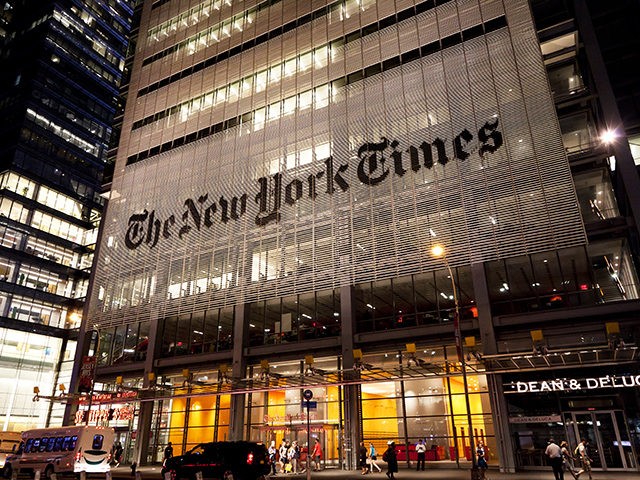CLAIM: The New York Times claims that President Donald Trump “could have seen what was coming” on coronavirus.
VERDICT: MOSTLY FALSE. The president considered the advice of experts and took some early, drastic actions.
The New York Times has published what could just as well be a Democratic National Committee oppo dump against Trump, claiming that he ought to have known what the coronavirus outbreak would mean, and acted to stop it from happening.
The article begins with an email on Jan. 28 — a day after the White House had already created its coronavirus task force, a day before President Trump was to chair a meeting of that task force, and three days before he banned travel with China.
It is true that President Trump moved from downplaying the threat of a coronavirus outbreak to waging “war” against it. But in doing so, he was also following the advice of scientists and career civil servants, who initially said the risk was low.
Dr. Anthony Fauci cautioned Jan. 21 that while we should “take it seriously,” the virus was “not a major threat to the people of the United States, and this is not something that the citizens of the United States right now should be worried about.”
In several speeches in late January, Trump reassured the nation that his administration had the situation under control — but he did not rule out that it could prove to be a bigger problem. “Hopefully it’s all going to be great. … but it’s something that we have to be very, very careful with,” he told a rally in Des Moines, Iowa, in the days before the Iowa caucuses.
The Times faults Trump for considering the effect of public health measures on the economy: “Even after Mr. Trump took his first concrete action at the end of January — limiting travel from China — public health often had to compete with economic and political considerations in internal debates.” But it is not clear how else Trump was to manage a threat whose impact was uncertain — and where many of the policy interventions he would have undertaken would have definite economic costs.
The Times also falsely assigns blame to the president for the failure of the test initially approved by the Centers for Disease Control and Prevention (CDC). It claims “the administration had botched the rollout of testing,” but in fact it was a problem that had nothing to do with Trump or his administration. As Dr. Fauci later said, the failure of the initial wave of tests had been no one’s “fault” in particular, but the result of an ordinary technical “glitch,” and “certainly not the president’s fault.”
Amazingly, the Times acknowledges that impeachment might have constrained Trump’s ability to act. But the newspaper accepts no responsibility for its own role — or that of the media, or the opposition — in supporting the impeachment trial.
Nor does the Times account for its own early, mistaken reporting on the coronavirus outbreak– such as an article in early January that declared in the sub-headline that a new illness in China “doesn’t appear to be readily spread by humans.”
The Times also fails to note that no other Western government, nor any state or local government, was prepared for the pandemic. It compares Trump to an ideal response, with 20/20 hindsight, rather than the actual, practical alternatives.
Not once does the Times acknowledge that the federal supply of emergency medical supplies had been depleted — and never replaced — by President Barack Obama’s administration. Nor does it note that the White House announced new, aggressive policies toward preventing pandemics last year — even if that effort anticipated an influenza, not a SARS-type of virus.
Much of the Times‘ criticism is focused on events at the end of February, when the administration — and the world — began to realize that the coronavirus was much more contagious than previously known, and that more aggressive responses might be necessary. The Times suggests that there were internal divisions inside the administration, and that Trump pushed back against some aggressive responses, like shutting down public events. But that internal struggle — and its resolution in favor of a shutdown — has nothing to do with the charge, in the Times headline, that Trump “could have seen what was coming.”
Meanwhile, in February, the Times reported that “fear” and “stigma” surrounding coronavirus was spreading “faster than the coronavirus itself” in Europe, quoting one business owner who called the “panic” around the virus “absolutely ridiculous.”
The president’s job was to weigh the risk of a pandemic against the risk of harming the economy. Initially, the chance of a pandemic seemed small. Ultimately, the risks to public health grew — and the president made decisions, accordingly.
The Times is second-guessing the president based on a false narrative, which started with a debunked story by ABC News last week, that the administration knew about the coronavirus threat well in advance. Historians will long debate whether the president acted in time, and whether he acted aggressively enough (or too aggressively). But the evidence suggests that he took a wide variety of views into account — including scientific experts — in balancing public health and economic needs.
In other words, he was doing his job. The Times calls that a failure. Once again, it substitutes opinion for news reporting.
Joel B. Pollak is Senior Editor-at-Large at Breitbart News and the host of Breitbart News Sunday on Sirius XM Patriot on Sunday evenings from 7 p.m. to 10 p.m. ET (4 p.m. to 7 p.m. PT). His new book, RED NOVEMBER, is available for pre-order. He is a winner of the 2018 Robert Novak Journalism Alumni Fellowship. Follow him on Twitter at @joelpollak.

COMMENTS
Please let us know if you're having issues with commenting.